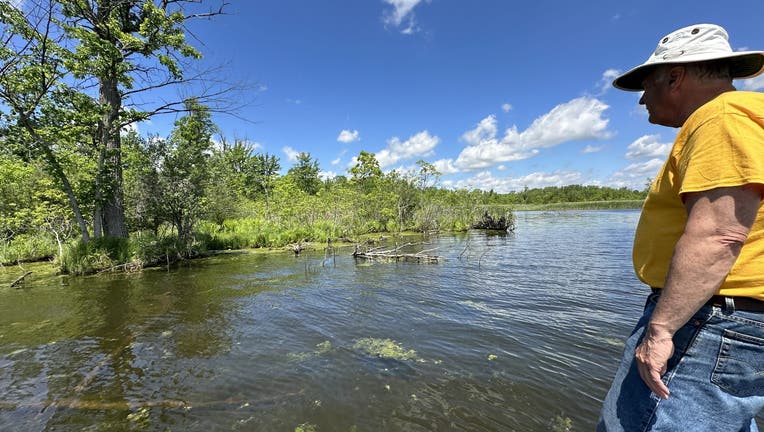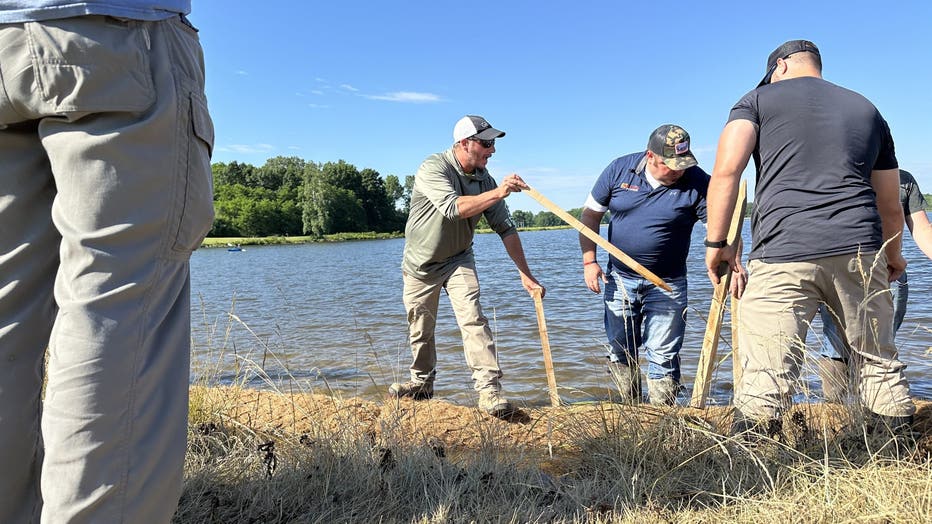Michigan's artificial shorelines are making its lakes sick. Can they be healed?

Craig Kivi on Portage Lake, where he owns a home and his family has lived for decades. Kivi worked to restore his shoreline with coarse woody structures.
PINCKNEY, Mich. (FOX 2) - When Craig Kivi looks out from his home on Portage Lake in Pinckney, he sees the symptoms of a sick lake.
Algae grows in heavy mats on the surface of Portage Lake. The stench of sewage wafts through when the breeze picks up. Plastic bottles and trash litter the shoreline.
"There are so many sicknesses that lakes get. And I hate to use that term because people get all alarmed, but that's the truth," he said. "I don't know how else to say it."
But on a pleasant Saturday afternoon of Memorial Day weekend, there was something else Kivi saw on the lake where his family has lived for generations: healing.
Hardy grasses grow at the shoreline, which hold the soil in place. Large stones help absorb wave energy from wake boats and extreme weather, keeping the shore in place. And just beyond the foliage is an experiment Kivi has been toying with.
Large 10-foot-long tree branches are tied together in groups of three and anchored into the soil. These "fish sticks," as Kivi calls them, don't look like much. But in the years since installing the bundles of wood, life has flourished.
"If you put wood in the water, all kinds of life will find some way to colonize around it," he said.
The first signs of life was a microscopic organism called periphyton, which prospers on the bark and helps purify the water. From there, baitfish began to appear and spawn in the habitat. Scientists that visited Kivi's experiment photographed the scene under the water and counted 17 fish in a single picture.
Birds were also attracted to the area, and so were turtles who used the branches to sunbathe. Suddenly, a slice of waterfront that was starved for life was teeming with it.
"Nature's been doing it forever. It's been going on for millions of years and only until we come to these lakes and say ‘we got to start putting up houses and take all the wood out," Kivi said. "As you look around here, there’s none. They took everything out."
Portage Lake, like hundreds of others in Michigan's Lower Peninsula, is surrounded by property. According to one 2012 estimate from the DNR, 91% of lakes in southern Michigan have varying forms of development. More than two-thirds had high levels of development.
As a result, the delicate balance watersheds need in order to thrive has been disturbed - and the impacts are far-reaching. Fisheries have disappeared, and water quality has suffered - which can keep people out of the same lakes they live next to.
Many homeowners installed seawalls to protect their yards from erosion. But a cascading impact follows with the metal barrier bouncing wave energy to other parts of the lake and eroding the land elsewhere. And even more consequential, it severs water from land.
Kivi, who works in real estate and has sold some of the homes on Portage Lake, says homeowners want their waterfronts "to look like swimming pool lakes." An unobstructed view of the lake, a crisp blue surface, and nothing else.
The only problem is, a healthy lake looks nothing like a swimming pool.
Building a shoreline
In the late morning of a June weekday, Brian Majka spoke to a crowd of around 30 people gathered at the beach at Stony Creek Metropark in Macomb County.
Normally, Majka is tasked with large-scale shoreline projects that sometimes take him to the Great Lakes. But on June 12, his job was as an instructor; teaching participants how to soften a shoreline, which involves installing habitat, removing man-made alterations, and reverting the landscape to a more natural state.

Brian Majka with GEI consultants, guides students about where to hammer in wooden posts to stabilize the shoreline.
Majika started by directing participants to drop logs made up of shredded coconut into the water, a few feet from the shore. Known as coir logs, they offer erosion control. To ensure they do not move, wooden stakes were hammered on alternating sides of the logs.
Majka used a chainsaw to cut notches into the stakes, which were then tied together with rope, further stabilizing the log. With the help of an excavator, dirt filled in the gap between the log and the land. Finally, a biodegradable fabric was laid over the new dirt.
Organized by the Michigan Natural Shoreline Partnership, the process is part of the group's workshops aimed at training others to install habitat and strengthen the natural boundaries on properties that border lakes and rivers.
With the foundation for a new shoreline constructed, the next step requires planting native grasses. Bill Schneider, who runs a plant nursery in mid-Michigan and is sometimes invited to assist at the workshops, had several plant species selected for the day.
Emergent plants can survive in water and land and are pretty to look at. Pollinators can attract insects, which help add to the local food chain, while hardier plants with deep root systems will armor the land, holding it in place.
It's best to think of a shoreline's plant diversity like a meal.
"This is the broth, holding the soil in place," said Schneider, feeling the stems of a bulrush plant that's already growing. "And then if you want to add a little spice, then you add plants like arrowhead and pickerel weed."
The tricky dance Schneider finds himself performing when guiding customers is picking out plants that benefit the environment while catering to the desires of the homeowner. There isn't always overlap between the two.
"They want to have big, wide open access to the water. They love the aesthetic of turf to the edge. This is antithetical," he said. "We're not against access to the water, but if you have an 80-foot lot, you shouldn't have 80 feet of turf right to the water's edge."
While these weren't the conversations Schneider was having at the start of his 28-year career, he says he's observed a shift in what homeowners want.
June's workshop was also about training contractors to meet any future demand from homeowners; in exchange, the Huron-Clinton Metroparks has received a new shoreline habitat – a "win-win," according to metropark's chief natural resources officer, Katie Carlisle.
"(This area) is a great example of the sites that contractors might find on private properties on lakes throughout Southeast Michigan." Carlisle said.
That factor is important to the partnership because of an observed cultural shift in what people want to do with their waterfronts. Instead of sea walls, homeowners are considering a softer approach.
"If we're going to meet that demand, these folks need to have knowledge on it," said Erick Elgin, an aquatic ecologist who doubles as an educator with the partnership. "And there is definitely demand. We haven't marketed this class heavily and it fills up every year."
Starving for habitat in the Great Lakes
In 2021 and 2022, officials from Canada and the U.S. conducted a first-of-its-kind survey assessing the abundance of fish in Lake St. Clair. Together, the DNR, the U.S. Fish and Wildlife Service, and the Ontario government used fyke and gill nets to catch species of fish.
For years, both countries worked in a vacuum – and their findings segregated from one another.
They caught common species like bluegill, large and smallmouth bass, yellow perch, and walleye. They also caught more rare fish species like pugnose shiner, spotted suckers, mooneye, and river redhorse.
But a glaring gap appeared in what both sides found.
"The big finding of that survey was on the Canadian side, there was a much higher catch rate and species diversity," said Andrew Briggs, a fisheries research biologist.
Briggs theorizes the primary reason for the difference lies in Canada's shoreline. Unlike the U.S., Canada's shoreline is only 50% armored. In the U.S., it's 90%.
"If you're going to harden shorelines, it's going to remove important fish habitat," he said. "A lot of spawning and nursery habitat – that needs protection to hide and feed. If those shorelines are hardened, it will impact fish populations."
So did the gradual changes to Lake St. Clair's shoreline alter the life that now inhabits its waters?
The cumulative impacts of small changes to the shoreline and their impacts were spelled out in a 2006 publication by the DNR, which outlined how to conserve Michigan's lakes and natural resources.
The Great lakes and the inland water bodies in Michigan face extraordinary pressure, from nutrient changes and contamination, to over-fishing and habitat loss. Like a Jenga tower, as vital pieces of the environment are altered or removed, the stability of the overall system is weakened.
Some efforts to put those pieces back into place have unfolded in recent years.
At the Ford House in Grosse Pointe Shores, a $7 million project aims to transform the shores protected by the man-made cove that was installed years ago. Plans to restore a mile of the shoreline include removing broken concrete armoring the coast and replace it with natural vegetation and coastal wetlands.
A groundbreaking for the project is scheduled for Sept. 14.
Further north in Anchor Bay is Brandenburg Park. For years, the township relied on seawalls to brace against wave action that would spill into the park. In 2020, crews installed shoals hundreds of feet away from the shoreline, buffering the lake. From there, 1.5 acres of near-shore habitat was built with native grasses and biodegradable fabric holding it all together.
It took less than a year for life to flourish in the area.
Monitoring after the project found major growth among fish populations, including more juveniles - which officials believe is due to better nursery habitat. Numbers of plant species tripled while the number of birds more than quadrupled.
From the perspective of the Great Lakes, the project represents a sliver of the shoreline. But it's also a sign of how nature responds when given a chance.
"What happens on land influences the water," said Erick Elgin, with the shoreline partnership.
For Craig Kivi, small projects may have a small impact – but with more work over time, that impact could grow exponentially.
"I have a theory, and that is that lakes can be restored by the reintroduction of natural habitats," he said. "Not by poisons, not even so much by regulation. On its own, it's really restoration that's going to get us there."

